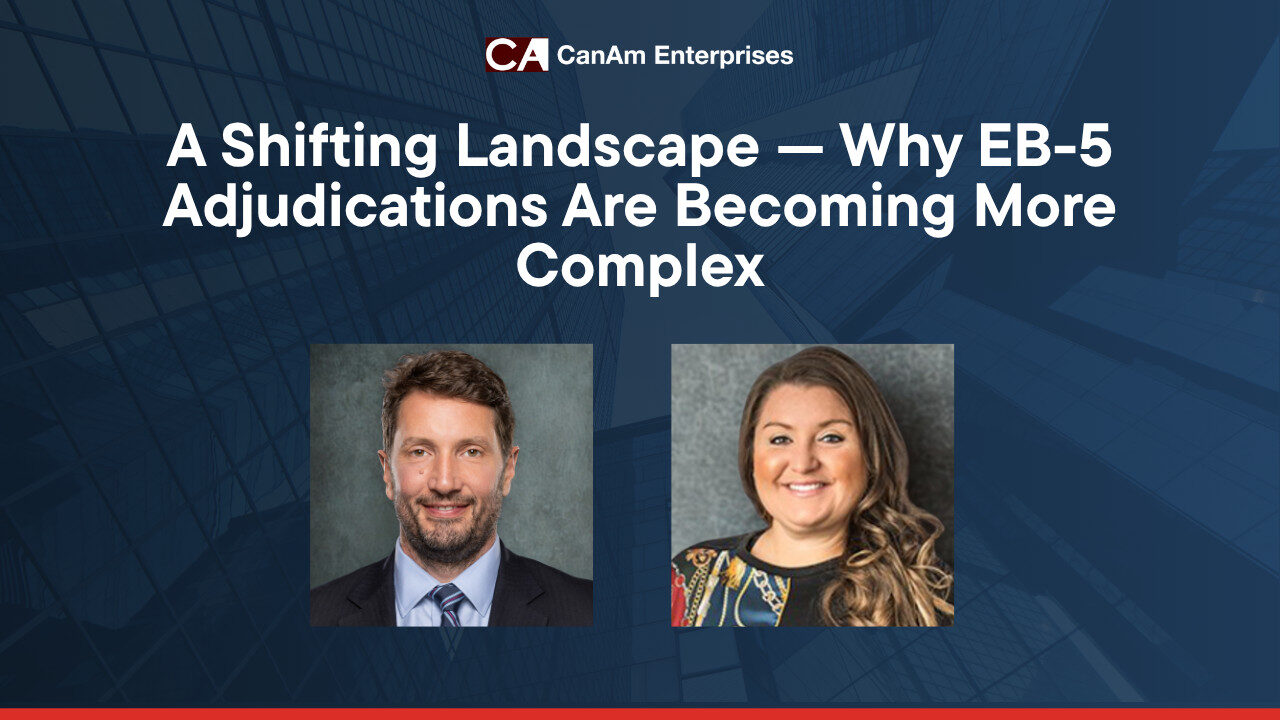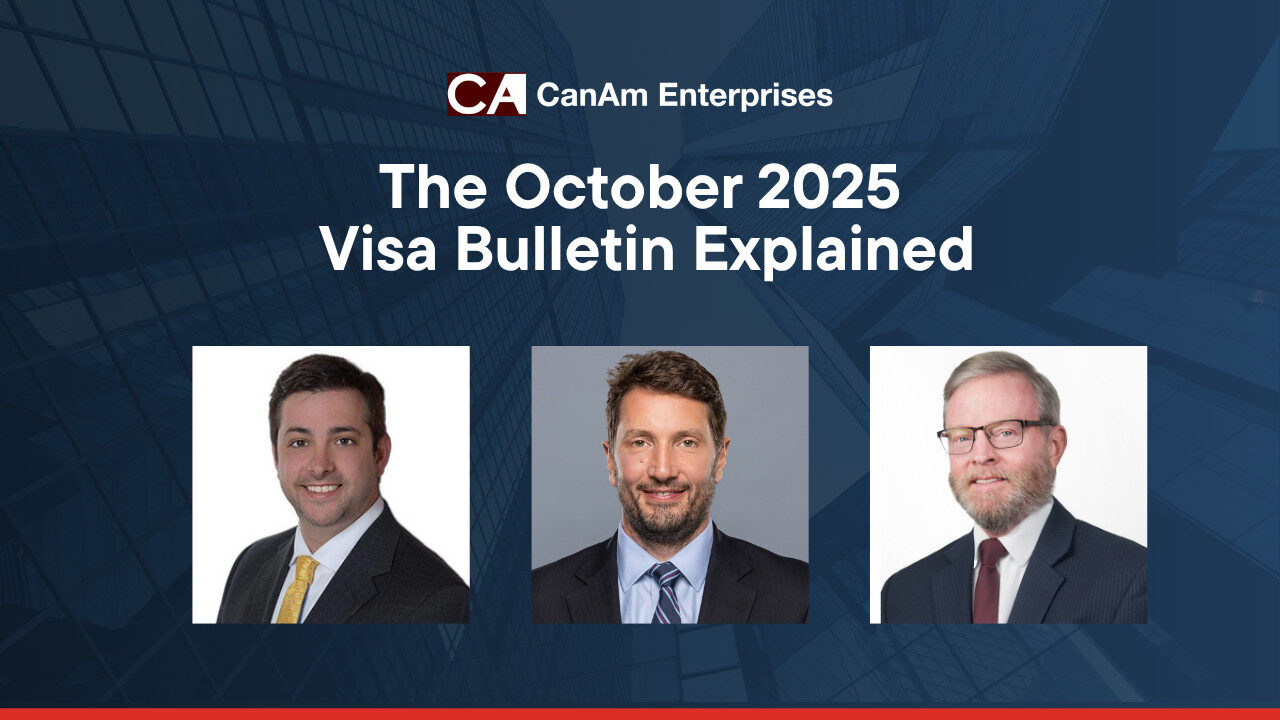Part 1 of CanAm’s Series on EB-5 Adjudication Trends with Jen Hermansky and Pete Calabrese
A New Era of Scrutiny
“The one thing everyone wants in EB-5 is predictability,” said Pete Calabrese, CEO of CanAm Investor Services, as he opened a recent webinar conversation with Jen Hermansky, Shareholder at Greenberg Traurig LLP and Chair of the firm’s EB-5 Committee.
That sentiment set the stage for a discussion that every prospective investor and advisor should hear: the landscape of EB-5 adjudications is shifting. What used to be “very approvable” is now often receiving deeper scrutiny, longer processing times, or in some cases, outright denials.
“Sometimes USCIS is issuing aggressive Requests for Evidence (RFEs). Sometimes they’re skipping straight to Notices of Intent to Deny. And sometimes,” Pete explained, “they’re denying petitions outright.”
In an environment where investors are making life-changing financial and immigration decisions, that unpredictability can be unnerving. But as Hermansky emphasized throughout the session, understanding why this is happening—and what you can do about it—is the first step toward reducing risk.
The Reform and Integrity Act Set the Stage
Hermansky began by noting that the EB-5 Reform and Integrity Act (RIA) of 2022 fundamentally reshaped the Program. “The RIA brought great protections for investors,” she said, “but it also set the stage for more complex adjudications.”
The Act introduced new compliance and disclosure requirements for regional centers, tighter rules around fund administration, and enhanced oversight of investor source-of-funds documentation. While these changes ultimately strengthen the Program, they also mean that USCIS examiners are examining every detail more closely than before.
“We’ve seen a surge in filings,” Hermansky added, pointing out that the grandfathering provision—allowing investors who file before September 30, 2026 to remain protected even if the Program sunsets—has created an understandable rush to secure a place in line. “That volume alone means more variation in how cases are reviewed.”
Why Predictability Matters More Than Ever
The EB-5 process is, at its heart, about confidence: confidence that your investment is compliant, that your petition will be approved, and that your path to permanent residency is clear.
When adjudication patterns shift, predictability erodes. For investors, that uncertainty can have real consequences—from delayed immigration benefits to jeopardized visa availability.
That’s why, as Calabrese explained, the focus at CanAm is on helping investors prepare cases that are fully approvable when filed. “Our goal is to make sure each investor has the strongest possible submission the first time around,” he said. “Predictability doesn’t come from luck—it comes from preparation.”
A Shift Toward ‘Tighter’ Interpretations
Both speakers noted that the current trend isn’t necessarily a change in the law—it’s a change in interpretation.
“Many of the concepts we’re dealing with—like being ‘in the process of investing’ or demonstrating funds are ‘at risk’—have been part of EB-5 since 1990,” Hermansky explained. “What’s new is how strictly those definitions are being applied.”
That stricter standard is showing up across a variety of areas:
- Installment or partial funding cases, where investors file before contributing the full $800,000.
- Loan-based funding, where proceeds come from bank or non-bank sources.
- Alternative investment vehicles, such as self-directed IRAs or family financing.
Each of these methods is still viable—but only if documented and structured exactly right. “The RIA didn’t remove flexibility,” she noted. “It raised the bar for demonstrating compliance.”
What This Means for Investors and Advisors
The good news: none of this makes EB-5 less accessible. It simply reinforces the importance of a strategic, compliant approach.
“When we approach these types of conversations,” Calabrese said, “we want to make sure we’re giving people practical advice they can use. Predictability leads to confidence, and confidence starts with a well-prepared petition.”
For investors, that means taking extra time to coordinate with both the regional center and immigration counsel to ensure that all documentation is complete and verifiable before filing. For advisors, it means setting clear expectations with clients: partial filings and creative funding structures may look efficient, but shortcuts can quickly become setbacks if USCIS pushes back.
Looking Ahead: From Adjudication Trends to Action Steps
Hermansky emphasized that increased scrutiny doesn’t necessarily signal hostility from USCIS—it reflects the agency’s effort to maintain the integrity of the Program amid rising demand. “EB-5 has grown significantly in the past few years, especially after the RIA,” she said. “With that growth comes a learning curve for adjudicators and investors alike.”
The takeaway: preparation and transparency are your best allies. As filings accelerate toward the September 2026 grandfathering deadline, USCIS will continue to refine its adjudication standards. Investors who understand those standards—and meet them head-on—will be best positioned for success.
What’s Next in the Series
This discussion is just the beginning. In the coming weeks, CanAm will publish additional articles exploring the key topics that Hermansky and Calabrese discussed in depth:
- Part 2: Filing Before You Fund It All — What USCIS Looks for in Partial EB-5 Investments
- Part 3: Loans and EB-5 — What’s Allowed, What’s Risky, and What’s New Under the RIA
- Part 4: Alternative Paths to EB-5 Funding — Using Self-Directed IRAs and Preparing for Success
Together, these pieces provide a practical guide to navigating today’s EB-5 environment—one that rewards careful planning and proactive compliance.





